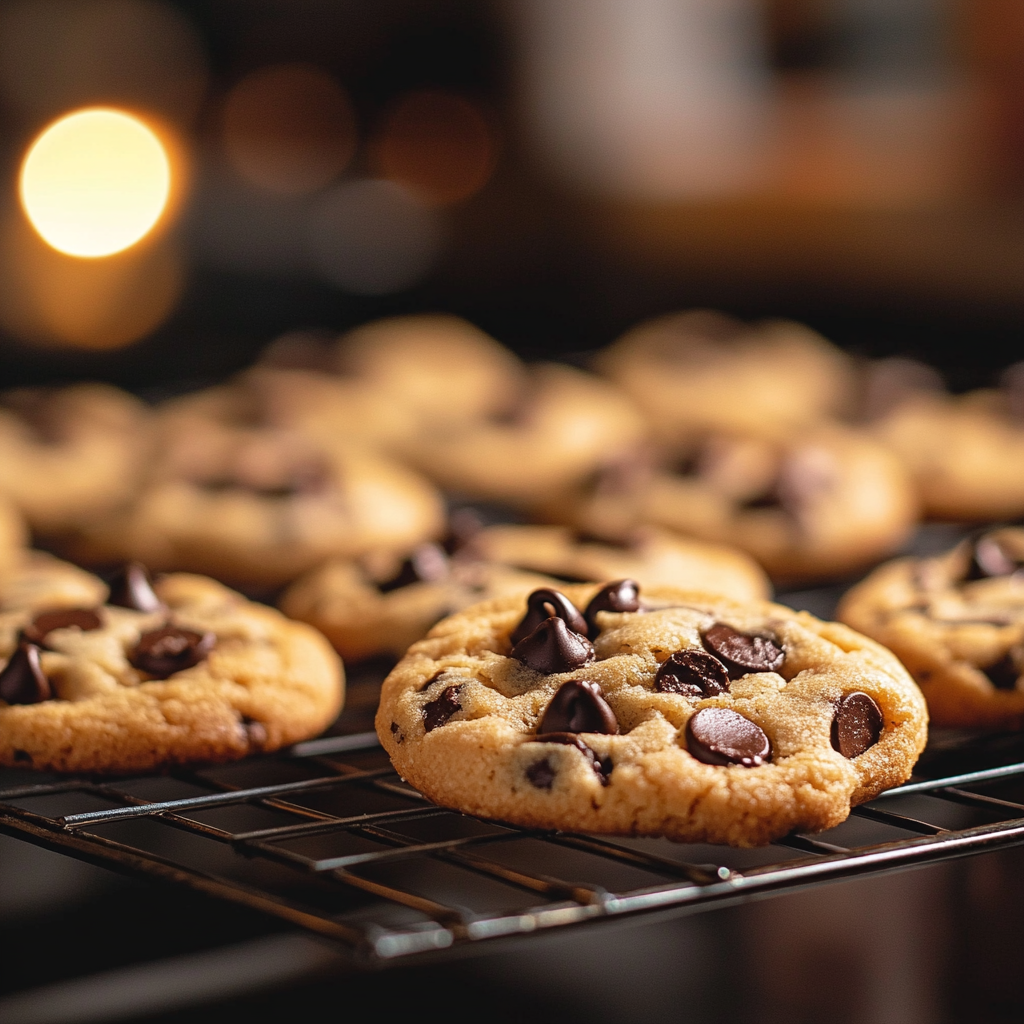Chocolate chip cookies are a timeless classic loved by people of all ages. Whether you’re a seasoned baker or just starting out in the kitchen, this recipe will guide you to creating soft, chewy, and irresistible chocolate chip cookies. Known for their sweet, buttery base and rich chocolate flavor, these cookies are perfect for any occasion—be it family gatherings, holiday treats, or a simple afternoon snack. https://royalesrecipes.com/how-many-calories-in-a-chocolate-chip-cookie/
What makes chocolate chip cookies so universally adored? It’s their simplicity combined with their versatility. With just a handful of pantry staples like flour, sugar, butter, and chocolate chips, you can whip up a batch of cookies that everyone will love. Plus, there’s always room to customize—whether you prefer gooey centers, crispy edges, or fun add-ins like nuts or oats.
Let’s get started on creating the most delicious chocolate chip cookies you’ve ever tasted!
cookies evoke happiness and familiarity worldwide.
Essential Ingredients for Chocolate Chip Cookies Recipe
Flour, Butter, and Sugar: The Foundation https://joyfoodsunshine.com/the-most-amazing-chocolate-chip-cookies/
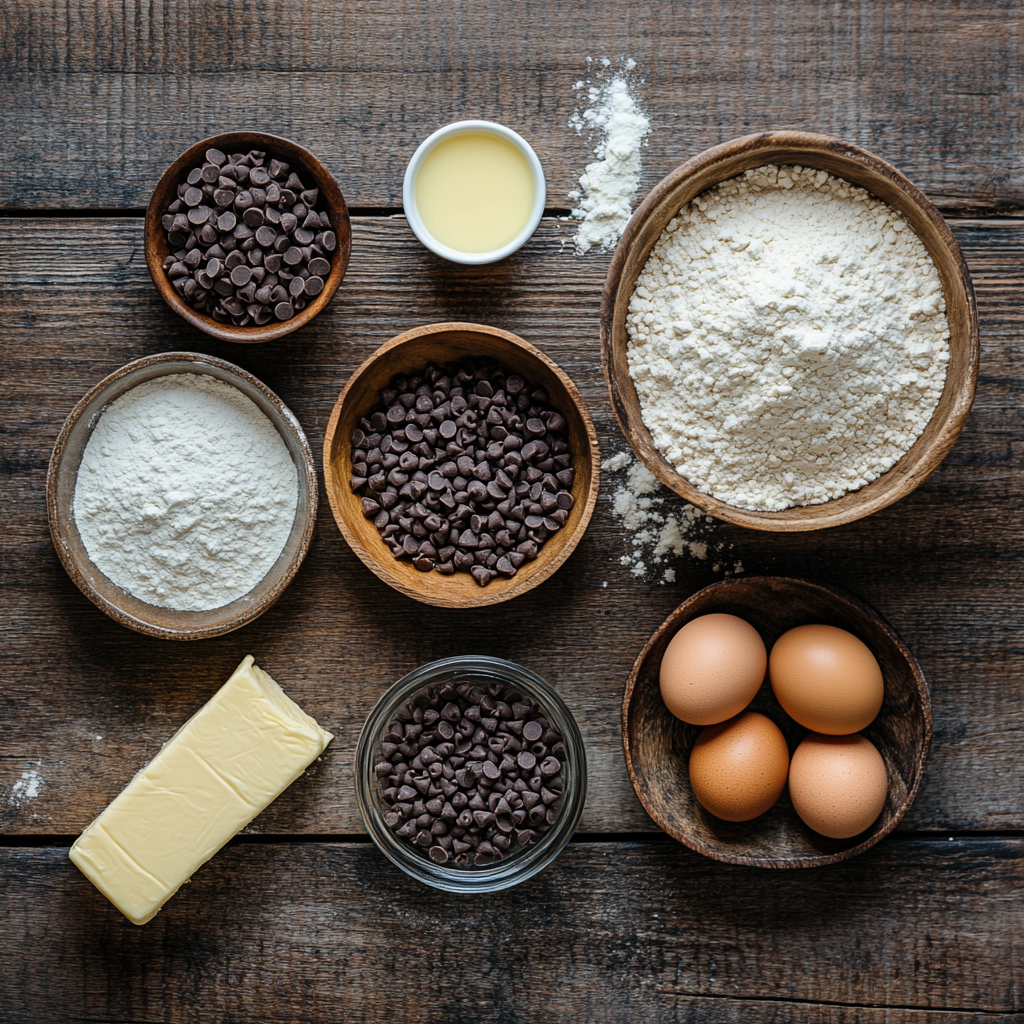
The foundation of any good chocolate chip cookie lies in three core ingredients: flour, butter, and sugar. Each one plays a vital role in achieving the perfect texture and flavor.
- Flour: All-purpose flour is most commonly used as it provides the right balance of structure and tenderness. If you prefer a softer cookie, try using cake flour, which has a lower protein content.
- Butter: Butter adds richness and flavor to your cookies. For the best results:
- Use unsalted butter to control the salt level in your recipe.
- Make sure the butter is softened (not melted) so it creams properly with sugar.
- Brown butter can be used for an extra nutty and deep flavor.
- Sugar: A combination of sugars is key for texture:
- Granulated sugar helps cookies spread and gives them crispy edges.
- Brown sugar keeps cookies soft and chewy due to its molasses content.
- Using more brown sugar than white sugar will result in softer, chewier cookies.
Choosing the Right Chocolate Chips for Chocolate Chip Cookies Recipe
The chocolate in your cookies is the star of the show, so it’s important to choose high-quality chocolate chips. Here are some options:
- Semi-Sweet Chocolate Chips: These are the classic choice, offering the perfect balance of sweet and bitter.
- Dark Chocolate Chips: For those who enjoy a richer, less sweet cookie, dark chocolate chips work wonderfully.
- Milk Chocolate Chips: Sweeter and creamier, these chips are ideal for a lighter flavor profile.
- Chocolate Chunks or Bars: Instead of chips, you can chop up a chocolate bar for larger, uneven pockets of melted chocolate.
Optional Add-Ins for Creativity
While classic chocolate chip cookies are perfect on their own, you can elevate them with creative add-ins:
- Nuts: Chopped walnuts, pecans, or almonds add crunch and a nutty flavor.
- Oats: Adding rolled oats creates a chewier texture and hearty flavor.
- Spices: A dash of cinnamon or nutmeg can add warmth and depth to your cookies.
- Dried Fruits: Chopped dried cherries, cranberries, or raisins offer a sweet, tangy twist.
- Sea Salt: Sprinkling sea salt on top of the cookies enhances the flavor and balances the sweetness.
By selecting the best ingredients and experimenting with fun add-ins, you can create chocolate chip cookies that are truly your own.
Step-by-Step Instructions for the Perfect Chocolate Chip Cookies Recipe
Preparation and Tools You Need for Chocolate Chip Cookies Recipe
Before diving into the baking process, make sure you have all the essential tools and ingredients prepared. Being organized will make the baking process smoother and more enjoyable. Here’s what you’ll need:
Tools:
- Mixing bowls (one large, one medium)
- Electric mixer or hand whisk
- Measuring cups and spoons
- Rubber spatula
- Baking sheet(s)
- Parchment paper or silicone baking mat
- Cooling rack
Ingredients:
- 2 ¼ cups all-purpose flour
- 1 teaspoon baking soda
- ½ teaspoon salt
- 1 cup (2 sticks) unsalted butter, softened
- ¾ cup granulated sugar
- ¾ cup packed brown sugar
- 1 teaspoon vanilla extract
- 2 large eggs
- 2 cups semi-sweet chocolate chips
- Optional: 1 cup chopped nuts (like walnuts or pecans)
Mixing and Combining Ingredients Properly of Chocolate Chip Cookies Recipe
Now that everything is set, let’s walk through the steps to make perfect chocolate chip cookies:
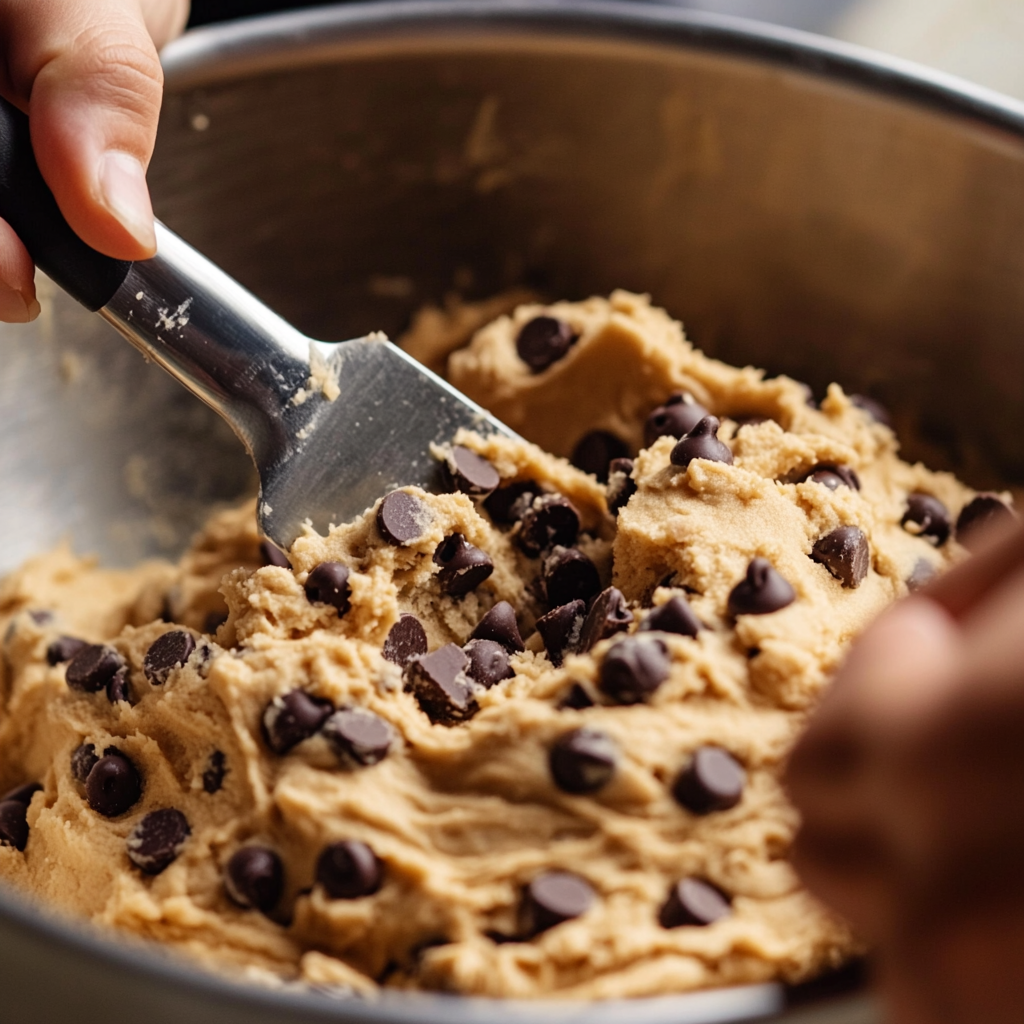
- Preheat the Oven:
Preheat your oven to 350°F (175°C). Line baking sheets with parchment paper or silicone baking mats to prevent sticking. - Mix the Dry Ingredients:
In a medium-sized bowl, combine the all-purpose flour, baking soda, and salt. Whisk them together until evenly mixed and set the bowl aside. - Cream the Butter and Sugars:
In a large mixing bowl, add the softened butter, granulated sugar, and brown sugar. Using an electric mixer on medium speed, cream the mixture until it’s light and fluffy (about 2-3 minutes). This step is essential for achieving cookies with the perfect texture. - Add Eggs and Vanilla:
Beat in the eggs, one at a time, ensuring each egg is fully incorporated before adding the next. Then mix in the vanilla extract. The mixture should be smooth and creamy. - Incorporate the Dry Ingredients:
Gradually add the dry flour mixture into the wet butter mixture. Use a low speed on your mixer or fold it in gently with a rubber spatula. Be careful not to overmix, as this can lead to tough cookies. Stop mixing as soon as no streaks of flour remain. - Fold in the Chocolate Chips:
Gently fold in the chocolate chips (and nuts, if using) using a spatula. This ensures they are evenly distributed throughout the dough.
Achieving the Right Dough Consistency
The consistency of your cookie dough is crucial to getting the perfect bake. The dough should be soft and slightly sticky but still hold its shape. If your dough seems too sticky to handle, refrigerate it for 15-20 minutes. Chilling the dough also helps prevent the cookies from spreading too much while baking.
If the dough seems too dry or crumbly, add a teaspoon of milk or water to loosen it up.
Shaping the Cookies
- Use a cookie scoop or tablespoon to portion out equal-sized scoops of dough. Place them on the prepared baking sheet, spacing each cookie about 2 inches apart to allow for spreading.
- For picture-perfect cookies, gently press a few extra chocolate chips onto the tops of each dough ball before baking.
Baking Techniques for Perfect Results of Chocolate Chip Cookies Recipe
Oven Temperatures and Timing
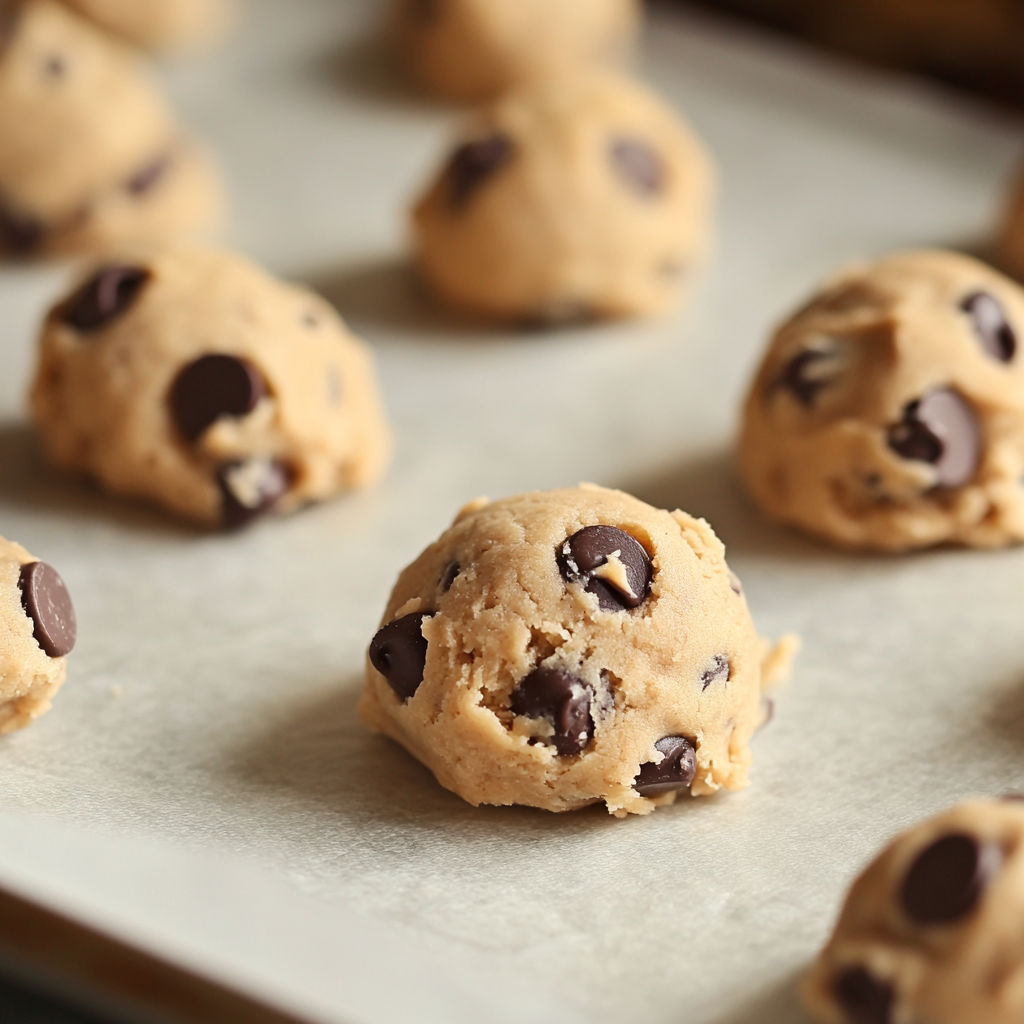
Place the baking sheet in the center rack of your preheated oven and bake at 350°F (175°C) for 9-12 minutes. Keep an eye on the cookies:
- For chewy cookies, bake until the edges are golden brown, but the centers still look slightly soft.
- For crispier cookies, leave them in for an extra 1-2 minutes until the entire surface turns golden.
How to Avoid Overbaking or Undercooking
- Watch the Edges: If the edges of the cookies are set and lightly browned but the center looks slightly underdone, take the cookies out of the oven. They will continue to set as they cool.
- Rotate the Baking Sheet: Halfway through baking, rotate the baking sheet to ensure even baking, especially if your oven has hot spots.
Once baked, remove the cookies from the oven and allow them to cool on the baking sheet for about 5 minutes. Then transfer them to a cooling rack to cool completely. This step ensures the cookies don’t overcook from the residual heat of the pan.
Tips for the Softest, Chewiest Chocolate Chip Cookies
Secrets to Perfect Texture
Achieving the soft, chewy texture that makes chocolate chip cookies so irresistible requires attention to a few key details:
- Use More Brown Sugar Than White Sugar:
Brown sugar contains molasses, which adds moisture and chewiness to cookies. A higher ratio of brown sugar to granulated sugar results in a softer cookie. - Don’t Overmix the Dough:
Overmixing the dough once the flour is added can develop too much gluten, leading to tough and dense cookies. Mix only until the flour is just incorporated. - Add Cornstarch:
A small amount of cornstarch (1-2 teaspoons) can make cookies softer and give them a light, tender texture. This is a popular baking secret for achieving bakery-style cookies. - Chill the Dough Before Baking:
Refrigerating the cookie dough for at least 30 minutes helps solidify the butter, preventing the cookies from spreading too much during baking. Chilled dough also produces a richer flavor as the ingredients have more time to meld. - Don’t Overbake:
The key to chewy cookies is removing them from the oven just before they look completely done. The edges should be golden brown, while the centers remain soft and puffy. Cookies will continue to set as they cool. - Add an Extra Egg Yolk:
Including an additional egg yolk (without the white) increases the fat content in the dough, resulting in richer and chewier cookies. - Use Room Temperature Ingredients:
Ingredients like butter and eggs should be at room temperature. This ensures they incorporate evenly, giving the cookies a smooth, consistent texture.
Cooling and Storing Your Cookies
Proper cooling and storage are just as important as the baking process to maintain your cookies’ freshness and texture.
- Cool on a Rack:
After baking, allow the cookies to rest on the baking sheet for 5 minutes, then transfer them to a wire cooling rack. Cooling them properly prevents soggy bottoms and helps them set. - Store in an Airtight Container:
Place cookies in an airtight container at room temperature. To keep them soft, place a slice of bread in the container—the cookies will absorb moisture from the bread and stay fresher for longer. - Freezing Cookies and Dough:
- Baked Cookies: Once fully cooled, you can freeze baked cookies in a sealed container or freezer bag for up to 3 months. Simply reheat them in a preheated oven at 300°F (150°C) for a few minutes before serving.
- Cookie Dough: Portion the dough into balls and freeze them on a baking sheet. Once firm, transfer the dough balls to a freezer bag. When you’re ready to bake, simply place the frozen dough on a baking sheet and bake as usual, adding an extra 1-2 minutes to the bake time.
- Reheating Cookies:
For that freshly baked taste, warm cookies in the microwave for 10 seconds or in the oven at a low temperature.
Popular Variations of Chocolate Chip Cookies
Double Chocolate Cookies
For chocolate lovers, double chocolate chip cookies take indulgence to the next level. These cookies replace part of the flour with cocoa powder, giving them a rich, chocolatey base. Add semi-sweet or white chocolate chips to the dough for extra bursts of sweetness.
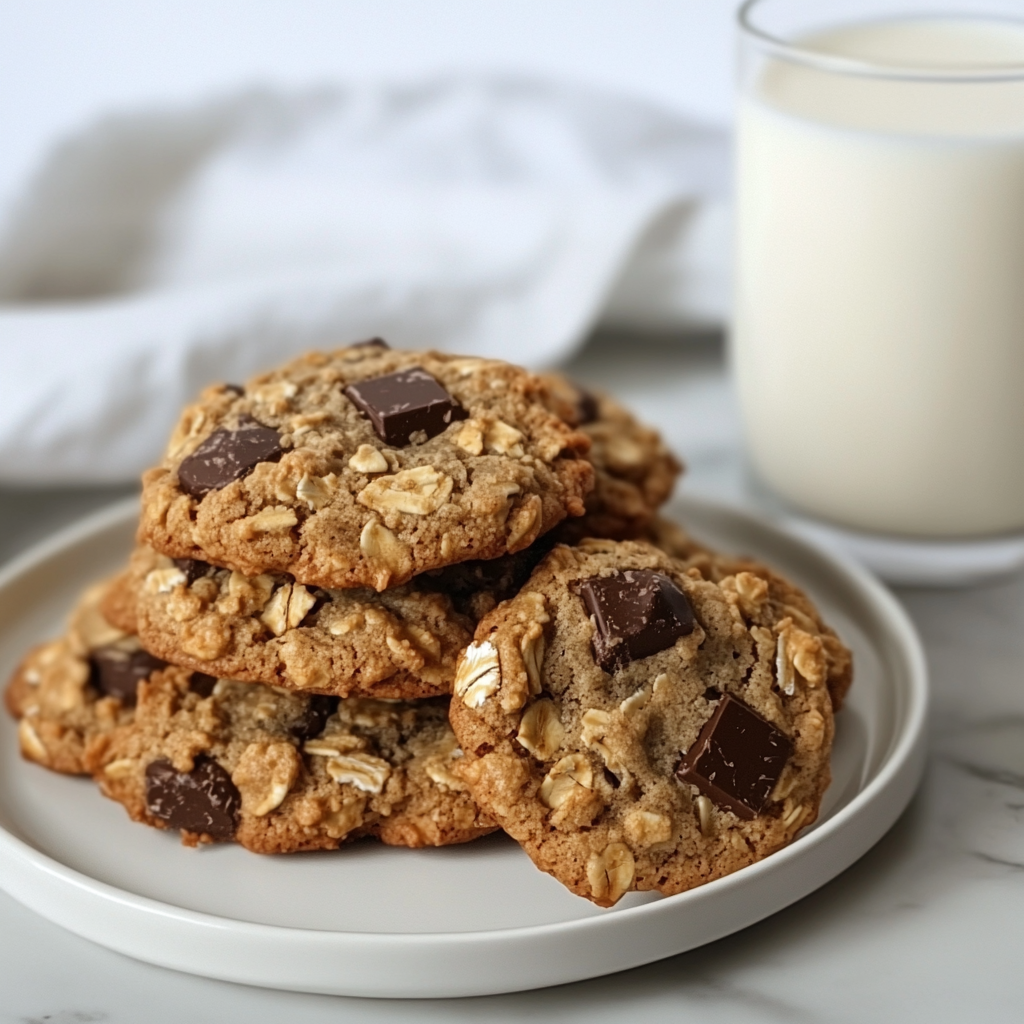
Quick Tip: Use Dutch-processed cocoa powder for a smoother, less acidic flavor.
Vegan and Gluten-Free Options
Chocolate chip cookies can easily be adapted to accommodate dietary restrictions without sacrificing flavor or texture:
- Vegan Chocolate Chip Cookies:
- Replace butter with coconut oil or vegan butter.
- Use flaxseed eggs (1 tablespoon flaxseed meal + 3 tablespoons water) instead of eggs.
- Ensure your chocolate chips are dairy-free.
- Gluten-Free Chocolate Chip Cookies:
- Substitute all-purpose flour with a gluten-free flour blend. Look for blends that contain xanthan gum, which helps mimic the elasticity of gluten.
- Add a tablespoon of almond flour for a nuttier flavor and softer texture.
Adding Nuts, Oats, and More
If you enjoy texture and added flavor in your cookies, here are a few creative ideas:
- Oatmeal Chocolate Chip Cookies:
Add 1 to 1.5 cups of rolled oats to your cookie dough for a heartier, chewy texture. These cookies are perfect for breakfast treats or snacks. - Nutty Chocolate Chip Cookies:
Mix in chopped walnuts, pecans, or almonds for a delightful crunch. Toasting the nuts beforehand enhances their flavor. - Salted Chocolate Chip Cookies:
A sprinkle of sea salt flakes on top of each cookie before baking balances the sweetness and adds a gourmet touch. - Stuffed Cookies:
Take your cookies up a notch by stuffing them with surprises like Nutella, peanut butter, or caramel. Simply flatten the dough, place a small spoonful of filling in the center, and wrap the dough around it before baking.
By exploring these variations, you can create endless versions of chocolate chip cookies tailored to your preferences.
Frequently Asked Questions (FAQs)
How Do I Prevent Flat Cookies?
Flat cookies are often caused by too-soft butter or overmixing the dough. Here’s how to avoid this issue:
- Chill the Dough: Refrigerate the dough for at least 30 minutes before baking. Cold dough spreads less and helps retain its shape.
- Measure Ingredients Accurately: Too little flour can cause cookies to spread too much. Use the “spoon and level” method to measure flour properly.
- Avoid Overmixing: Mix the dough until just combined after adding flour to prevent too much air from forming, which flattens cookies.
- Check Butter Consistency: Ensure butter is softened, not melted. Melted butter makes the dough greasy and prone to spreading.
What Type of Chocolate is Best?
The type of chocolate you choose can change the overall flavor of your cookies. Here are some options:
- Semi-Sweet Chocolate Chips: The classic choice for traditional chocolate chip cookies, offering a good balance of sweetness and bitterness.
- Dark Chocolate: Ideal for those who love a richer, less sweet flavor. Use 60-70% cocoa for deep, intense notes.
- Milk Chocolate: Sweeter and creamier, milk chocolate is great for a lighter, more kid-friendly cookie.
- Chocolate Chunks or Bars: Chopping up high-quality chocolate bars creates larger, uneven pools of melted chocolate, giving the cookies a gourmet feel.
For the ultimate cookies, mix different types of chocolate (like semi-sweet chips and dark chocolate chunks) to add complexity and depth.
Can I Freeze the Dough for Later?
Absolutely! Freezing cookie dough is a great way to prepare ahead of time and enjoy freshly baked cookies whenever you like. Here’s how to do it:
- Portion the Dough: Scoop the dough into individual balls and place them on a baking sheet lined with parchment paper.
- Flash Freeze: Freeze the dough balls for 1-2 hours until firm.
- Store Properly: Transfer the frozen dough balls into a freezer-safe bag or airtight container. Label with the date. Frozen dough will last up to 3 months.
- Bake from Frozen: Place the frozen dough balls on a baking sheet and bake as directed, adding an extra 1-2 minutes to the bake time.
Why is My Dough Too Sticky or Dry?
- Sticky Dough: If your dough is too sticky to handle, it may be due to warm butter or too little flour. To fix it, chill the dough for 15-30 minutes to firm up or add a tablespoon of flour at a time until it reaches the desired consistency.
- Dry Dough: Dry, crumbly dough is often caused by too much flour or not enough fat. Add a small amount of milk (1 teaspoon at a time) or soften extra butter and fold it in until the dough comes together.
How Do I Store Chocolate Chip Cookies?
Proper storage keeps your cookies fresh and delicious for days:
- At Room Temperature: Store cookies in an airtight container for up to 1 week. To keep them soft, add a slice of bread or a marshmallow inside the container.
- In the Refrigerator: While refrigeration is not necessary for most cookies, you can refrigerate them for up to 2 weeks. Make sure they’re in an airtight container to prevent drying out.
- In the Freezer: Place cookies in a freezer bag or airtight container and freeze for up to 3 months. Thaw them at room temperature or warm them in the oven before serving.
Can I Replace Butter with Oil?
Yes, but it will affect the texture of your cookies. Butter provides flavor and richness, while oil makes cookies denser and chewier. To substitute:
- Use ¾ cup of oil for every 1 cup of butter.
- Choose neutral-flavored oils like vegetable or canola oil.
For a similar result to butter, try using coconut oil or vegan butter alternatives. Keep in mind that cookies made with oil may spread more, so chilling the dough beforehand is even more important.
Conclusion
Chocolate chip cookies are an enduring favorite for a reason—they’re simple, versatile, and always delicious. Whether you’re baking a batch for a family gathering, a special treat, or just because, this recipe provides everything you need for success. From selecting the best ingredients to mastering baking techniques and troubleshooting common issues, you now have all the tools to create perfectly soft, chewy, and irresistible chocolate chip cookies every time.
Experiment with different variations like double chocolate, oatmeal, or vegan options, and don’t be afraid to make the recipe your own with creative add-ins. After all, the joy of baking lies in the process and the smiles these classic cookies bring.
So grab your mixing bowl, preheat the oven, and get ready to enjoy the sweet aroma of freshly baked chocolate chip cookies filling your kitchen. Happy baking!

